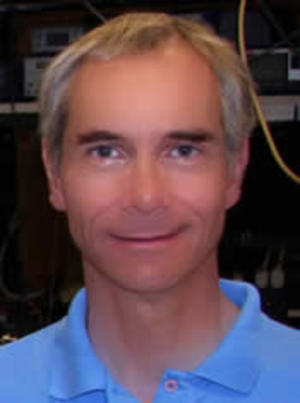When a large protein unfolds in transit through a cell, it slows down and can get stuck in traffic. Using a specialized microscope -- a sort of cellular traffic camera -- University of Illinois chemists now can watch the way the unfolded protein diffuses.
By looking at the dynamics of how the unfolded protein moved in the cell (A), the researchers mapped areas in the cell with different rates of diffusion (B and C). | Photo courtesy Hannah Gelman
Studying the relationship between protein folding and transport could provide great insight into protein-misfolding diseases such as Alzheimer’s and Huntington’s. Chemistry professor Martin Gruebele and graduate students Minghao Guo and Hannah Gelman published their findings in the journal PLOS ONE.
“We’re looking at the earliest stages of disease, the initial phases of transport of bad proteins,” Gruebele said. In the past, he said, much research on Alzheimer’s and similar disease focused on fibrils, large bundles of misfolded proteins that form in the brain.
“But now, we think the fibrils are just an end product that’s left over when the cell dies, and the actual killing mechanism has to do with migration of the protein to specific places in the cell like the outer membrane,” he said. “Understanding how these mechanisms work at a fundamental level is going to give people more handles on where to look to cure things.”
Researchers have hypothesized that an unfolded protein moves more slowly through the cell, because it would be a big, stringy mess rather than a tightly wrapped package. The Illinois team devised a way to measure how diffusion slows down when a protein unfolds using a fluorescence microscope, then used three-dimensional diffusion models to connect the protein’s unfolding to its motion.
The researchers found that the unfolded protein did indeed slow down, although its speed was not steady. It sometimes zoomed swiftly to a new location, and sometimes sat idling in one area, like a vehicle in stop-and-go rush-hour traffic. They were able to map out areas of the cell with different rates of diffusion, the cellular version of a speed limit.
The unfolded protein’s slowdown is not only due to size, however. The researchers did additional experiments to prove that the unfolded protein stuck to other molecules in the cell. A class of molecules in the cell called chaperones have the job of binding to parts of proteins that come unfolded, and the researchers found that the unfolded protein interacted more with chaperones than did the properly folded protein. However, when high numbers of proteins unfold, the cell’s systems can get overloaded and the chaperones can’t handle them all.
UIUC's News Bureau original article, author - Liz Ahlberg
